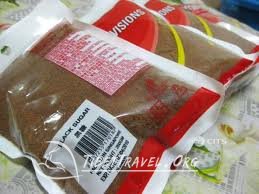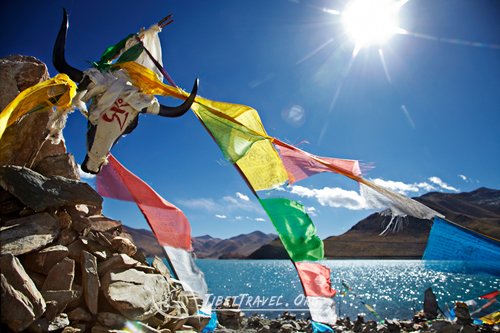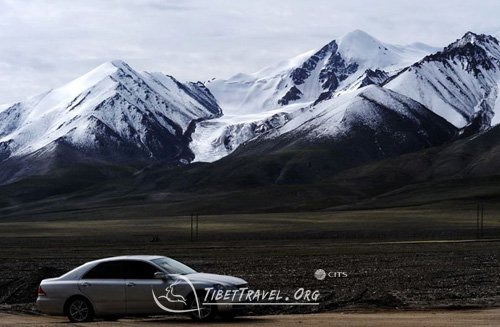2014年10月22日星期三
Recommend Itineraries
-newline"> For most travellers, visiting Tsang means a straight shot from Lhasa to the Nepali border, with stops at Gyantse, Shigatse and Mt Everest. This journey
takes about eight days if done at a reasonable pace.
From Lhasa, head out on the Southern Friendship Hwy, which takes you over the Kamba-la pass to the shores of Yamdrok-tso, then on to
Nangartse and Gyantse. You’ll need a full day in Gyantse before you can move on to Shigatse. West of Shigatse the next obvious stop is Lhatse,
but there are two worthy side trips on the way - Sakya Monastery and Phuntsoling Monastery. From Lhatse it’s on to Baber and Shegar, a key
stop before heading on to Everest Base Camp (EBC). Back on the main highway there is old Tingri and Nyalam before you finally reach the
border town of Zhangmu. The best hike in the region is from old Tingri to EBC (or vice versa), which will add another four days to your journey.
If you are in a hurry, it’s quicker to take the Northern Friendship Road when travelling between Lhasa and Shigatse but going this way you’ll miss
Gyantse, one of the highlights of Tsang. Any way you go you’ll find good facilities along the way and relatively easy drives as the Friendship Hwy is
entirely paved. The exception is the Everest region, which has dirt roads and basic accommodation.
2014年10月8日星期三
Highlights in Lhasa
Follow monks, mendicants and fellow pilgrims around the
Barkhor, Lhasa’s fascinating medieval pilgrim circuit.
Join the shuffling lines of awed pilgrims around the glowing
shrines of the Jokhang, Tibet’s holiest temple.
Go down into the bowels of the Potala, the impressive but
spiritless citadel of the Dalai Lamas.
Take in a prayer meeting or some monk-debating at Sera
and Drepung, two of the largest and most intact of Tibet’s great
monasteries.
A day out to Ganden Monastery and test your sin on its
fascinating kora.
Explore the traditional whitewashed architecture, teashops
and craft workshops of Lhasa’s backstreets on our Old
Town Walking Tour.
Track down one of Lhasa’s off-the-beaten-track
temples, such as the Meru Nyingba Monastery or Tengye Ling.
Get a taste of the northern Changtang at the turquoise
waters, snowy peaks and nomads’ tents of stunning high-altitude
Lake Namtso.
Marvel at the turquoise waters of Yamdrok-tso, one of
Tibet’s most sacred lakes.
Barkhor, Lhasa’s fascinating medieval pilgrim circuit.
Join the shuffling lines of awed pilgrims around the glowing
shrines of the Jokhang, Tibet’s holiest temple.
Go down into the bowels of the Potala, the impressive but
spiritless citadel of the Dalai Lamas.
Take in a prayer meeting or some monk-debating at Sera
and Drepung, two of the largest and most intact of Tibet’s great
monasteries.
A day out to Ganden Monastery and test your sin on its
fascinating kora.
Explore the traditional whitewashed architecture, teashops
and craft workshops of Lhasa’s backstreets on our Old
Town Walking Tour.
Track down one of Lhasa’s off-the-beaten-track
temples, such as the Meru Nyingba Monastery or Tengye Ling.
Get a taste of the northern Changtang at the turquoise
waters, snowy peaks and nomads’ tents of stunning high-altitude
Lake Namtso.
Marvel at the turquoise waters of Yamdrok-tso, one of
Tibet’s most sacred lakes.
2014年9月10日星期三
What is Aliens' Travel Permits (PSB's)
Tibet is slightly more complicated when it comes to travel permits than elsewhere in China. An Alien Travel Permit (usually just called a ‘travel permit’) is granted by the PSB (Public Security Bureau) for travel to an area that is officially closed.
Tibet PSB will not issue travel permits to individuals and the travel permits are usually only obtainable through tour operators, for organized tours by four-wheel-drive car. A single permit is normally issued to all the people who are traveling together, the permit naming just one of them and stating how many others are accompanying him; the passports, or at least photocopies of passports and visas, of all persons traveling must be presented in order to obtain a permit.
If you want to do an overland tour from Yunnan, Sichuan or Xinjiang province to Tibet, your Entry Stamp to China is required to apply the PSB before your tour starts.
Tibet PSB will not issue travel permits to individuals and the travel permits are usually only obtainable through tour operators, for organized tours by four-wheel-drive car. A single permit is normally issued to all the people who are traveling together, the permit naming just one of them and stating how many others are accompanying him; the passports, or at least photocopies of passports and visas, of all persons traveling must be presented in order to obtain a permit.
If you want to do an overland tour from Yunnan, Sichuan or Xinjiang province to Tibet, your Entry Stamp to China is required to apply the PSB before your tour starts.
2014年8月24日星期日
Tsamda Hot Springs
The odourless, iron-rich springs are about 12km west of Tingri, and are piped directly into the pools of the Tsamda Snow Leopard Hot Spring Hotel (dm Y40, d Y200-280). Most travellers are not very impressed with the public pools, but you can rent a private room with bath for Y50 for a couple hours if the place is not busy. The private bath is a bit rough, too, and stained red in places from the iron in the water, but it’s just the thing for cleaning yourself off after a day or two at Everest Base Camp.
The hotel makes for a better stop than Tingri. There’s a common room on the 2nd floor with outstanding views, and some pleasant easy walks around the nearby hills. And the hot-spring water, despite the basic setup, is actually very good quality and the perfect temperature for soaking in.
The hotel makes for a better stop than Tingri. There’s a common room on the 2nd floor with outstanding views, and some pleasant easy walks around the nearby hills. And the hot-spring water, despite the basic setup, is actually very good quality and the perfect temperature for soaking in.
2014年7月28日星期一
A amazing food that keep you away from high altitude illness
Scientific researchers of former Soviet Union Tadzhikistan Mountain Institute, through research, has found that black sugar has pretty good effect on preventing high altitude illness. Those who go to a place with an altitude of more than 3600m can almost avoid high altitude illness by having 30g black sugar each day. While, those who don’t have black sugar or only have fine white sugar have a much higher risk of high altitude illness. The scientific researchers believe that there might be comparatively more active substances in black sugar which make it pretty effective on strengthening people’s ability to guard against high altitude illness.


2014年7月1日星期二
Who is the first mankind stand on the top of Mt. Everest
There is a photo famous of the world because of recording of the first man to climb Mount Everest on 29 May 1953. In this picture, Nepal guide Tenzing Norgay stood on the peak with an ice on his hand over head which surmounted a flag flutter. And the one who took this picture is the world's first successful ascent -- New Zealand mountaineer Edmund Hillary.
Hillary was born on July 20, 1919, whose father was a veteran. During World War II, he joined the Air Force. After the war he became a climbing obsession. Once, during he and George Los climbing the Alps, the sudden idea of mount Everest expedition came out. The idea got the world's support of Mountaineering Association at that time.
In 1953, after the success of climb Mount Everest Hillary was living in Everest Base Camp, George Los witnessed the process of Hillary and Norgay return to the Base camp. He recalled: "It was Edmund exposed weary smile, then all of a sudden sitting on the ice said with his usual tone: 'OK, we conquered the guy.'"
After the mount Everest expedition, Hillary was later knighted by the Queen, but he once wrote in his book: "(was knighted) for me is an extraordinary honor, but what I did not match that I deserved, I even could not believe myself have get canonized. "
Hillary established a foundation named after his own name, the Foundation is currently invested in Nepal and established 27 schools, two hospitals and more than a dozen clinics. Hillary's family is also engaged in the work of the Foundation, in 1975, his wife and daughter to participate in Foundation activities in Nepal killed in a plane crash.
Nowadays, tours to Everest base camp is become more and more easy for people who want to experience the feeling of climbing the highest peak of the world.
Hillary was born on July 20, 1919, whose father was a veteran. During World War II, he joined the Air Force. After the war he became a climbing obsession. Once, during he and George Los climbing the Alps, the sudden idea of mount Everest expedition came out. The idea got the world's support of Mountaineering Association at that time.
In 1953, after the success of climb Mount Everest Hillary was living in Everest Base Camp, George Los witnessed the process of Hillary and Norgay return to the Base camp. He recalled: "It was Edmund exposed weary smile, then all of a sudden sitting on the ice said with his usual tone: 'OK, we conquered the guy.'"
After the mount Everest expedition, Hillary was later knighted by the Queen, but he once wrote in his book: "(was knighted) for me is an extraordinary honor, but what I did not match that I deserved, I even could not believe myself have get canonized. "
Hillary established a foundation named after his own name, the Foundation is currently invested in Nepal and established 27 schools, two hospitals and more than a dozen clinics. Hillary's family is also engaged in the work of the Foundation, in 1975, his wife and daughter to participate in Foundation activities in Nepal killed in a plane crash.
Nowadays, tours to Everest base camp is become more and more easy for people who want to experience the feeling of climbing the highest peak of the world.
2014年6月12日星期四
Five ways of getting to Tibet
How to go to Tibet? Which way is better among the five ways of getting to Tibet, by train, by flight, by jeep, by bike or on foot? The answer depends on your purpose of going to Tibet, your physical condition, your time and so on.

Is it your dream travel to visit the fabulous landscape of Tibet? Or do you just want to view the breathtaking scenery along the way to Tibet? Are you an outdoor adventurer? Do you need a trip to clean up your soul? Ask yourself why travel to Tibet. Different purpose different way.
When you only have a short holiday, fly to Lhasa directly. If you are a backpacker, trek to Lhasa. If you are an auto enthusiast, drive to Tibet. If you are an outdoor enthusiast, cycle to Tibet. I believe there is a way right for you.
1、By train to Tibet, it will cost you more time. But you will be rewarded with amazing scenery along the railway, a great chance to make friends on the train and lower cost.

2、By air to Tibet is only for a busy man. But he will also enjoy a visual impact of the bird’s view of the mysterious landscape of the Tibetan plateau. Though the cost is a little higher, its convenience and speediness are the reward for your money.
3、Driving to Tibet is very popular among Chinese tourists to Tibet, especially among auto enthusiasts. It is more independent on arranging the time and places to visit, but also requires more energy and carefulness. The biggest reward is more chance to visit more rare scenery and different experience. Driving to Tibet is also a good way to reduce the impact of high altitude sickness as you will go upward gradually from several hundred meters to 5000m.

4、Cycling to Tibet requires good physical condition and strong willpower, motivation and courage. But it is really an interesting and great experience for young people. Actually there are also many seniors cycling to Tibet every year.

5、Trekking to Tibet is the hardest way, but it is just a piece of cake for those devout Tibetan pilgrims. The pilgrims would spend several years, even their whole life of trekking to Tibet, even prostrating to Tibet.

So which way is the best for you? You have the final say. No matter which way you choose to Tibet, Tibet is a place deserving your visit. For some people, it is a lifetime trip to Tibet.
Currently, you can go to Tibet by train via the Qinghai-Tibet railway, from Beijing, Shanghai, Chengdu, Guangzhou, Xining and Xi'an, or by flight from Beijing, Shanghai, Chengdu, Shangri-la, Kunming, Guangzhou, Chongqing, Xian, Xining and Kathmandu, or by jeep from Sichuan, Yunnan, Xinjiang and Qinghai to Tibet along the highways.
订阅:
博文 (Atom)